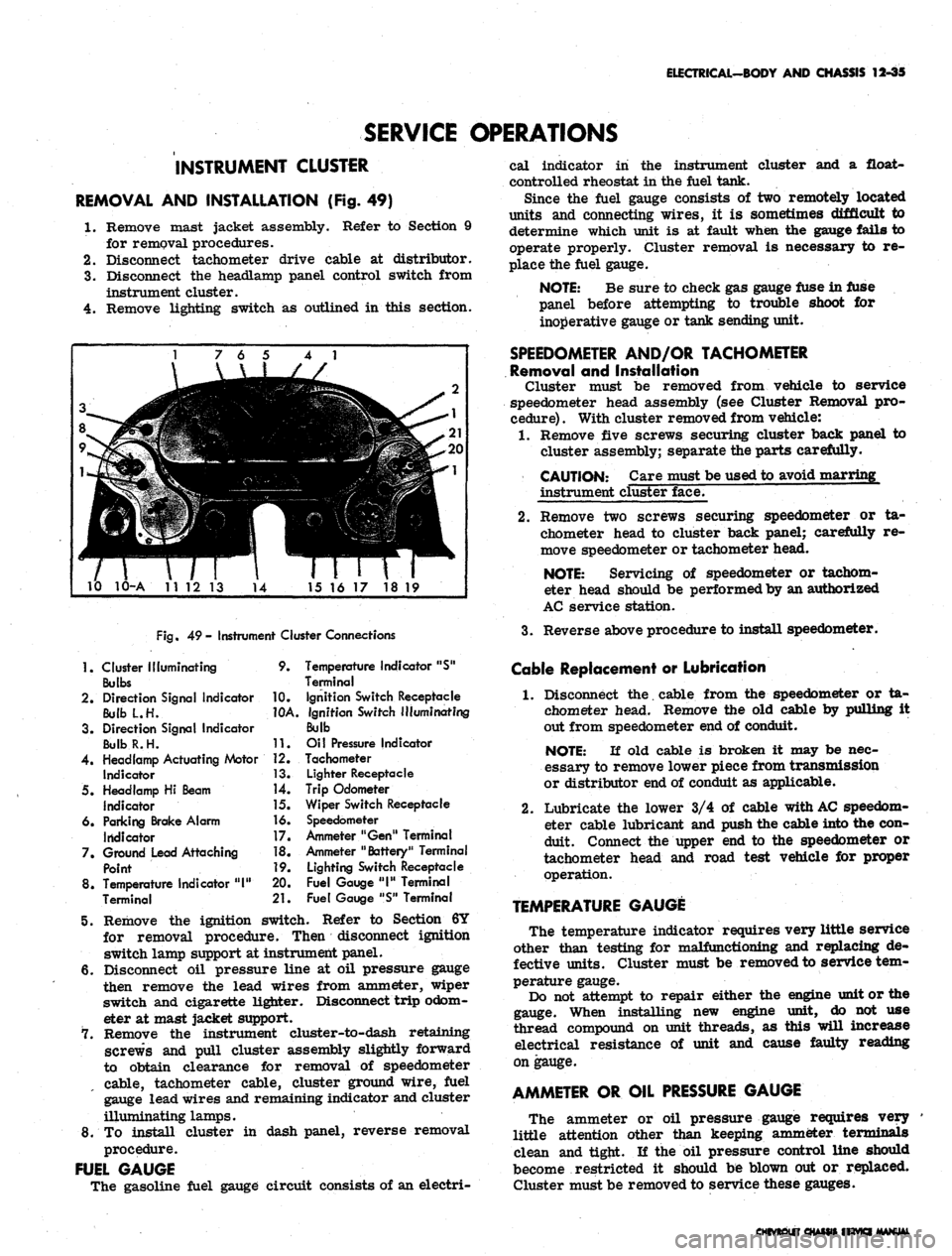odometer CHEVROLET CAMARO 1967 1.G Chassis Workshop Manual
[x] Cancel search | Manufacturer: CHEVROLET, Model Year: 1967, Model line: CAMARO, Model: CHEVROLET CAMARO 1967 1.GPages: 659, PDF Size: 114.24 MB
Page 547 of 659

ELECTRICAL-BODY AND CHASSIS 12-35
SERVICE OPERATIONS
INSTRUMENT CLUSTER
REMOVAL AND INSTALLATION (Fig. 49)
1.
Remove mast jacket assembly. Refer to Section 9
for removal procedures.
2.
Disconnect tachometer drive cable at distributor.
3.
Disconnect the headlamp panel control switch from
instrument cluster.
4.
Remove lighting switch as outlined in this section.
10 10-A 1112 13
14
15 16 17 18 19
Fig.
49- Instrument Cluster Connections
1.
Cluster Illuminating
Bulbs
2.
Direction Signal Indicator
Bulb L.H.
3. Direction Signal Indicator
BulbR.H.
4.
Headlamp Actuating Motor
Indicator
5. Headlamp Hi Beam
Indicator
6. Parking Brake Alarm
Indicator
7. Ground Lead Attaching
Point
8. Temperature Indicator
"1"
Terminal
9.
10.
10A.
11.
12.
13.
14.
]5.
16.
17.
18.
19.
20.
21.
Temperature Indicator "S"
Terminal
Ignition Switch Receptacle
ignition Switch Illuminating
Bulb
Oil Pressure Indicator
Tachometer
Lighter Receptacle
Trip Odometer
Wiper Switch Receptacle
Speedometer
Ammeter "Gen" Terminal
Ammeter "Battery" Terminal
Lighting Switch Receptacle
Fuel Gauge
"1"
Terminal
Fuel Gauge "S" Terminal
5. Remove the ignition switch. Refer to Section 6Y
for removal procedure. Then disconnect ignition
switch lamp support at instrument panel.
6. Disconnect oil pressure line at oil pressure gauge
then remove the lead wires from ammeter, wiper
switch and cigarette lighter. Disconnect trip odom-
eter at mast jacket support.
7. Remove the instrument cluster-to-dash retaining
screws and pull cluster assembly slightly forward
to obtain clearance for removal of speedometer
cable, tachometer cable, cluster ground wire, fuel
gauge lead wires and remaining indicator and cluster
illuminating lamps.
8. To install cluster in dash panel, reverse removal
procedure.
FUEL GAUGE
The gasoline fuel gauge circuit consists of an electri-
cal indicator in the instrument cluster and a float-
controlled rheostat in the fuel tank.
Since the fuel gauge consists of two remotely located
units and connecting wires, it is sometimes difficult to
determine which unit is at fault when the gauge fails to
operate properly. Cluster removal is necessary to re-
place the fuel gauge.
NOTE:
Be sure to check gas gauge fuse in fuse
panel before attempting to trouble shoot for
inoperative gauge or tank sending unit.
SPEEDOMETER AND/OR TACHOMETER
Removal and Installation
Cluster must be removed from vehicle to service
speedometer head assembly (see Cluster Removal pro-
cedure)
.
With cluster removed from vehicle:
1.
Remove five screws securing cluster back panel to
cluster assembly; separate the parts carefully.
CAUTION: Care must be used to avoid marring
instrument cluster face.
2.
Remove two screws securing speedometer or ta-
chometer head to cluster back panel; carefully re-
move speedometer or tachometer head.
NOTE:
Servicing of speedometer or tachom-
eter head should be performed by an authorized
AC service station.
3.
Reverse above procedure to install speedometer.
Cable Replacement or Lubrication
1.
Disconnect the. cable from the speedometer or ta-
chometer head. Remove the old cable by pulling it
out from speedometer end of conduit.
NOTE:
If old cable is broken it may be nec-
essary to remove lower piece from transmission
or distributor end of conduit as applicable.
2.
Lubricate the lower 3/4 of cable with
AC
speedom-
eter cable lubricant and push the cable into the con-
duit. Connect the upper end to the speedometer or
tachometer head and road test vehicle for proper
operation.
TEMPERATURE GAUGE
The temperature indicator requires very little service
other than testing for malfunctioning and replacing de-
fective units. Cluster must be removed to service tem-
perature gauge.
Do not attempt to repair either the engine unit or the
gauge. When installing new engine unit, do not use
thread compound on unit threads, as this will increase
electrical resistance of unit and cause faulty reading
on gauge.
AMMETER OR OIL PRESSURE GAUGE
The ammeter or oil pressure gauge requires very
little attention other than keeping ammeter terminals
clean and tight. If the oil pressure control line should
become restricted it should be blown out or replaced.
Cluster must be removed to service these gauges.
HftVKI MANUAL